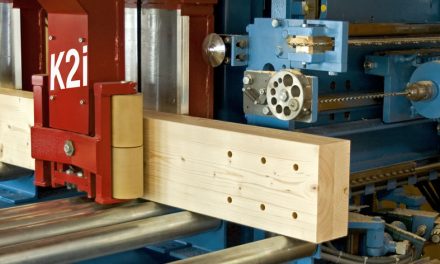Saw millers invest $900m in industry future – despite growing log supply shortfall.
Australian saw millers and associated manufacturers have invested an estimated $900 million over the last five years in efficiency and productivity initiatives on the back of strong demand for timber fuelled by the booming housing market.
The investment comes despite uncertainty around the future availability of logs to process, with Australia’s sawn wood production set to fall increasingly short of demand – the deficit in sawn timber is likely to rise from a predicted 1.1 million cubic metres in 2025 to 2.7 million cubic metres in 2045.
These were among the findings of a new research report commissioned by Forest and Wood Products Australia (FWPA) examining the sums invested, areas of investment and benefits sought across softwood and hardwood saw millers, panel plants and plywood operations.
The data in the report by Omega Consulting shows a combined total of $473 million was invested between 2012 and 2017 by the operations surveyed – implying total investment across the entire industry of approximately $938 million.
Anecdotal stakeholder feedback suggested conditions are currently buoyant, thanks to the booming Australian housing market, and the industry’s significant expansion capacity is being recognised.
Jim Houghton, Statistics and Economics Manager of FWPA, welcomed the investment, and said technology could help industry to increase the amount of sawn timber produced from the same volume of logs, and boost the use of residues to form new and innovative materials.
“The analysis demonstrated investment is healthy and a definite priority within the industry. This level of investment can only mean positive things for the future of our industry. The anecdotal feedback from processors also suggests more could be done if there were greater certainty around future log supply,” he said.
“The uncertainty over future log supply can be attributed to the limited expansion of the softwood plantation estate during the past 20 years and resultant static availability of softwood sawlogs. Concurrently, the availability of hardwood sawlogs has declined as access to the native forest has been reduced.”
The CEO of Omega Consulting, Peter Zed, said the predicted deficit in sawn wood was due to increasing demand driven by predicted population growth.
“A whole-of-industry approach is needed to address supply issues, reduce the deficit, and help prevent it from causing a significant barrier to future investment,” he said.
“Both sawmill efficiency and productivity need to be increased if we’re going to reduce the log supply deficit and inspire industry stakeholders with the confidence they need to make optimum investments.
This can be achieved through an increased focus on product niche and dedicated R&D around technologies to increase recoveries.”
The report FWPA Australian Timber Industry Investment Review can be read in full at http://www.fwpa.com.au/statistics-count-newsletter/1403-fwpa-australian-timber-industry-investment-review.html










